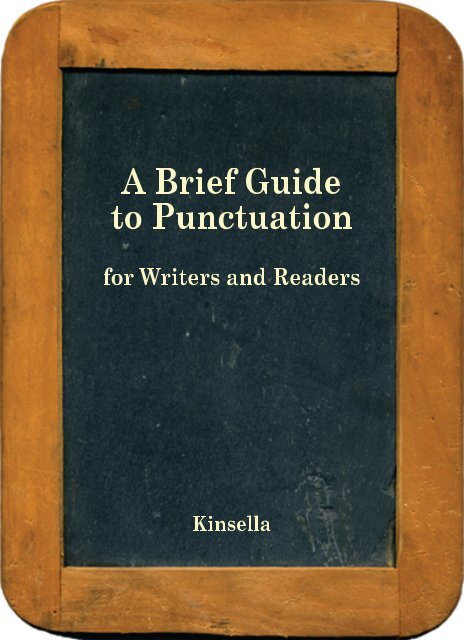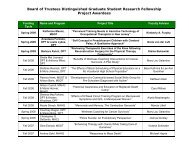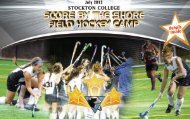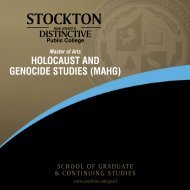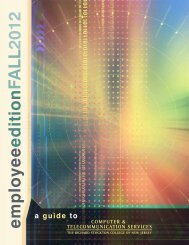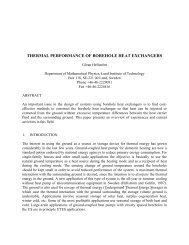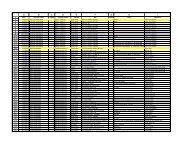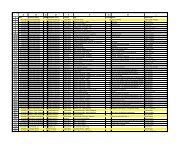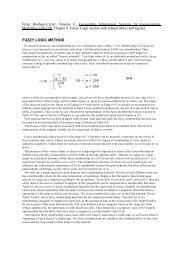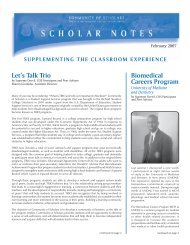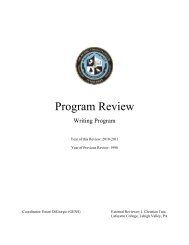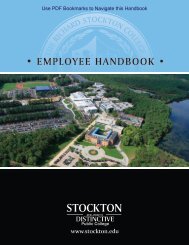Brief Guide to Punctuation - Stockton College
Brief Guide to Punctuation - Stockton College
Brief Guide to Punctuation - Stockton College
Create successful ePaper yourself
Turn your PDF publications into a flip-book with our unique Google optimized e-Paper software.
A <strong>Brief</strong><strong>Guide</strong><br />
<strong>to</strong><strong>Punctuation</strong><br />
forWritersandReaders<br />
Kinsela
A <strong>Brief</strong> <strong>Guide</strong> <strong>to</strong> <strong>Punctuation</strong>
A <strong>Brief</strong> <strong>Guide</strong> <strong>to</strong> <strong>Punctuation</strong><br />
for Writers and Readers<br />
by Thomas E. Kinsella<br />
A member of the Literature Program at<br />
S<strong>to</strong>ck<strong>to</strong>n <strong>College</strong>
Copyright © Thomas E. Kinsella, 2012<br />
Epub edition ISBN 978-1-936435-00-5<br />
A <strong>Brief</strong> <strong>Guide</strong> <strong>to</strong> <strong>Punctuation</strong> is distributed free of charge. When<br />
shared, attribution must remain with Thomas E. Kinsella. This<br />
work may not be used for commercial purposes, and may not be<br />
altered, transformed, or built upon.<br />
Feel free <strong>to</strong> contact me with comments at<br />
kinsella@earthlink.net<br />
2012
Table of Contents<br />
This guide has two parts. The first offers brief explanations of the<br />
more significant forms of punctuation; the second gives examples<br />
of light and heavy punctuation.<br />
I. <strong>Punctuation</strong> expresses meaning 7<br />
<strong>Punctuation</strong> over time 7<br />
Reading punctuation 8<br />
<strong>Guide</strong> <strong>to</strong> punctuation 9<br />
Commas in a list 9<br />
Commas with adjectives 9<br />
Commas between independent clauses 11<br />
Commas setting apart wording 12<br />
Commas with introduc<strong>to</strong>ry phrases<br />
and clauses 13<br />
Restrictive and nonrestrictive wording 13<br />
Which hunt 15<br />
Appositives 16<br />
Commas with parenthetical wording 16<br />
Commas with concluding phrases and clauses 17<br />
Commas and contrasting wording 18<br />
Commas and omitted material 19<br />
Implied vs. actual subjects 19<br />
Comma don’ts 19<br />
Semicolons 21<br />
Semicolons and conjunctive adverbs 21<br />
Semicolons in complex series 22<br />
Colons 23<br />
Colons, semicolons, and periods 24<br />
A common mistake with colons 25<br />
Dashes and parentheses 25
Apostrophes 27<br />
Possessive pronouns 28<br />
Punctuating quotations 29<br />
<strong>Punctuation</strong> used <strong>to</strong> introduce quotations 31<br />
Hyphens 32<br />
The Use of Ellipses 32<br />
Then vs. than 37<br />
Incomplete sentences 38<br />
II. Weighting punctuation 39<br />
Lighter and heavier punctuation 40<br />
Essay checklist 46<br />
Glossary 47<br />
A life with punctuation, briefly 49<br />
Front advertisement is taken from The Bos<strong>to</strong>n Almanac for the Year 1867;<br />
back advertisement, from Peterson’s Ladies National Magazine, April 1880.
INTRODUCTION<br />
7<br />
<strong>Punctuation</strong> expresses meaning<br />
Experience is the most important component in any study of<br />
punctuation — experience reading and analyzing well-punctuated<br />
texts and experience writing well-punctuated texts.<br />
This guide is no substitute for that experience. Still, it offers<br />
insights that should help writers better understand the potential<br />
of punctuation. As a component of effective writing, punctuation<br />
may not be as important as word choice, phrasing, or logical organization,<br />
but it is important. Strip punctuation from a well-written<br />
paragraph, and what is the result but a mass of words, difficult <strong>to</strong><br />
understand. In the hands of skillful writers, punctuation supports<br />
and enhances writing. <strong>Punctuation</strong> itself expresses meaning, and<br />
good writers use it in meaningful ways.<br />
<strong>Punctuation</strong> over time<br />
The norms of English punctuation have changed over time.<br />
Throughout the hand-press period of English printing, from the<br />
sixteenth century through the eighteenth, punctuation styles<br />
varied from author <strong>to</strong> author, from one printing house <strong>to</strong> the next.<br />
Commas, semicolons, and colons were not used consistently <strong>to</strong><br />
clarify relationships between syntactic elements — words, phrases,<br />
and clauses. Early punctuation often represented rhe<strong>to</strong>rical pauses<br />
and was quantitative in nature: a semicolon signaled a lighter<br />
pause than a colon and a comma, a lighter pause than both.<br />
During the second half of the nineteenth century, conventions<br />
began <strong>to</strong> take on recognizably modern form, although even a casual<br />
reading of poetry and novels from the period uncovers unfamiliar<br />
practices. Throughout the twentieth century, most stylists advocated<br />
increasingly lighter punctuation. Texts from the early decades are<br />
far more heavily punctuated than texts that date from the end of the<br />
century.
8 INTRODUCTION<br />
One legacy of these shifting norms is the broad range of<br />
acceptable usage available <strong>to</strong> practiced writers <strong>to</strong>day. When a more<br />
traditional and perhaps more authoritative effect is warranted,<br />
heavier punctuation is used. When a simpler, speedier, or more<br />
casual effect is needed, lighter punctuation is employed. Regardless<br />
of desired effect, all sentences need <strong>to</strong> be thoughtfully punctuated.<br />
Understanding and applying appropriate punctuation is an<br />
acquired skill that involves calculated decisions. These pages are<br />
designed <strong>to</strong> help you make those decisions.<br />
Reading punctuation<br />
I have subtitled this guide “for Writers and Readers.” Just as<br />
it is important that authors punctuate in meaningful ways, it is<br />
invaluable that readers understand the meaning of punctuation.<br />
Usage and interpretation are circular acts. If readers ask authors<br />
<strong>to</strong> punctuate with care, then authors will expect readers <strong>to</strong> understand.<br />
So this is not solely a guide for writers, but for readers, <strong>to</strong>o.
COMMAS<br />
9<br />
<strong>Guide</strong> <strong>to</strong> punctuation<br />
Speech conveys meaning through words, gestures, voice modulation,<br />
and pauses. Writing conveys meaning through words and<br />
punctuation alone. <strong>Punctuation</strong>, accordingly, must be versatile<br />
and flexible.<br />
Commas in a list<br />
Disagreement exists over the need for a comma between the last<br />
two items in a series when joined by a conjunction.<br />
The backyard garden contained pota<strong>to</strong>es, snap peas[,] and catnip.<br />
This comma is known as the serial, terminal, Oxford, or New<br />
Yorker comma. In 2011 the Oxford Styleguide recommended<br />
against its use. Nevertheless, use of the serial comma is well established<br />
and permissible.<br />
The gardener was on the lookout for slugs, bugs, rabbits and cats.<br />
Here it is not used. Is the gardener on the lookout for slugs, bugs,<br />
rabbits, and cats or for slugs and bugs and also rabbits with cats?<br />
The decision is yours. If you choose not use a serial comma make<br />
sure there can be no confusion about your meaning.<br />
Commas with adjectives<br />
Use a comma between consecutive coordinate adjectives. Don’t<br />
use a comma between cumulative adjectives. Coordinate adjectives<br />
modify the same noun equally and separately.<br />
Literature students favor long, difficult, page-turning books.
10 COMMAS<br />
When coordinate, the word and could join each adjective. Coordinate<br />
adjectives also make sense if rearranged.<br />
Literature students favor long and difficult and page-turning<br />
books.<br />
Literature students favor page-turning, difficult, long books.<br />
It was a playful, colorful noise.<br />
It was a colorful, playful noise.<br />
She smiled at the thought of the desperate, dark acts ahead.<br />
She smiled at the thought of the dark, desperate acts ahead.<br />
Some adjectives are cumulative and should not be separated<br />
with commas.<br />
Janey smelled the earthy Brazilian coffee.<br />
She then plunged fork in<strong>to</strong> sweet cherry pie.<br />
Did you see the five small brown rats taking a swim?<br />
The room had that pungent old book smell.<br />
not: The room had that pungent book old smell.<br />
possibly: The room had that old pungent book smell.<br />
The modification power of cumulative adjectives is suggested by<br />
their name. One adjective modifies a noun, and a second adjective<br />
(or a third, or more) modifies the noun and the other adjective(s).<br />
Sometimes the determination that adjectives are coordinate or<br />
cumulative, and thus <strong>to</strong> use commas or not, is a matter of interpretation.<br />
Below is an example of heavier, but acceptable punctuation
COMMAS<br />
11<br />
that views pungent and old as part coordinate and part cumulative.<br />
The room had that pungent, old book smell.<br />
Note the change in meaning when pungent and old are reversed.<br />
The room had that old, pungent book smell.<br />
When determining the punctuation of multiple adjectives, carefully<br />
consider the effects of different comma placements and choose<br />
the one that corresponds <strong>to</strong> your intended meaning.<br />
Commas between independent clauses<br />
When joining independent clauses with coordinating conjunctions<br />
— and, but, or, nor, for, so, yet — place a comma before the<br />
conjunction.<br />
Wild April winds blew hard, and spring seemed stuck somewhere<br />
in the Carolinas.<br />
The journey <strong>to</strong> the cafeteria <strong>to</strong>ok time, but time was a luxury that<br />
Janey could ill afford.<br />
The street was quiet as she walked that evening, yet through a<br />
curtained window she could hear Dylan sing the blues.<br />
It seemed a perfect morning for a canoe ride, so he chose his<br />
favorite paddle and walked <strong>to</strong>ward the dock.<br />
The aurors would not surrender, nor would the demen<strong>to</strong>rs surrender.<br />
Short independent clauses joined by coordinating conjunctions<br />
often drop the comma.
12 COMMAS<br />
It was cold but it felt swell.<br />
Janey ran and Dylan followed.<br />
Go home and read books!<br />
The final example above is imperative. It can be described as two<br />
independent clauses or as a single clause with two verbs.<br />
Commas setting apart wording<br />
Commas are used <strong>to</strong> set apart words, phrases, and clauses.<br />
Isolat ing wording from other parts of a sentence affects meaning<br />
in a variety of ways. Skillful writers manipulate these separations<br />
expressively.<br />
Yes, I believe we ought <strong>to</strong> have a pool.<br />
You, Timothy, need <strong>to</strong> take a swim.<br />
She did not, she said, understand the complexity of the request.<br />
She did not understand the complexity, she said.<br />
Zoey, an aging poodle, often sleeps on the couch.<br />
The day after Christmas, I believe it was a Monday, the turkey<br />
returned <strong>to</strong> the woods.<br />
These sentences have moved beyond simple subjects and predicates.<br />
Commas set off wording in order <strong>to</strong> expand upon, interrupt,<br />
or redirect the overall meaning of a sentence.
COMMAS<br />
13<br />
Commas with<br />
introduc<strong>to</strong>ry phrases and clauses<br />
Use a comma <strong>to</strong> set off introduc<strong>to</strong>ry phrases and clauses.<br />
In the wake of the oatmeal scandal, the children gave up cooking<br />
in the root cellar.<br />
Near the cut through the rock face, they found an old Model-T<br />
wreck.<br />
Realizing that the end was near, he turned his face <strong>to</strong> the ground<br />
and quietly wept.<br />
Whenever I make it back home, I drive <strong>to</strong> the lake and remember.<br />
Introduc<strong>to</strong>ry wording normally modifies some portion, or all of<br />
the remainder of a sentence. Its placement at the opening of a sentence,<br />
set off by a comma, suggests emphasis.<br />
Commas are often omitted after short introduc<strong>to</strong>ry phrases,<br />
especially prepositional phrases. Light punctua<strong>to</strong>rs may omit<br />
commas even after lengthy passages. Be sure meaning is clear.<br />
After dinner the children returned <strong>to</strong> play.<br />
Before long their attention turned back <strong>to</strong> oatmeal.<br />
At the end of the day they cleaned up their mess.<br />
Restrictive and nonrestrictive wording<br />
When modifying nouns, writers sometimes add wording that is<br />
necessary <strong>to</strong> the fundamental meaning of a sentence; other times<br />
they add wording that is nonessential, although useful. Wording<br />
that is necessary is described as restrictive; it must remain. Word-
14 COMMAS<br />
ing that is not necessary is described as nonrestrictive; it could be<br />
dropped. Decide what parts of a sentence <strong>to</strong> emphasize or <strong>to</strong> deemphasize;<br />
then use commas <strong>to</strong> mark the decision.<br />
Nonrestrictive wording is set off by commas; restrictive is not.<br />
Shakespeare’s tragedy Hamlet is often revived in London and New<br />
York.<br />
Macbeth, a tragedy by Shakespeare, is often dramatized on All-<br />
Hallows Eve.<br />
King Lear, a tragedy in five acts, is one of the great triumphs of<br />
literature.<br />
In the first example, the title Hamlet is restrictive. If it were dropped,<br />
the meaning of the sentence would no longer be clear. Do not set<br />
apart such wording with commas. In the second example, a tragedy<br />
by Shakespeare is nonrestrictive and should be set apart. It is expected<br />
that readers know Macbeth is a tragedy and that Shakespeare<br />
wrote it. The same holds true for the third example.<br />
not. Any reader, who reads <strong>to</strong>o quickly, will miss the major points<br />
of the work.<br />
not. George Eliot’s novel, Middlemarch, is a long and perturbing<br />
book.<br />
If who reads <strong>to</strong>o quickly were dropped from the first sentence and<br />
Middlemarch from the second, neither would make sense.<br />
Tristram Shandy by Laurence Sterne is a work that should be read<br />
slowly.<br />
The intended audience determines punctuation. If in the previous<br />
example they should know Sterne is the author, it may be punctuated<br />
with nonrestrictive commas.
COMMAS<br />
15<br />
Tristram Shandy, by Laurence Sterne, is a work that should be read<br />
slowly.<br />
Using commas <strong>to</strong> mark restrictive or nonrestrictive wording is<br />
perhaps the most important convention in modern punctuation.<br />
Which hunt<br />
That and which are pronouns used at the opening of adjectival<br />
clauses: that the boys looked in<strong>to</strong> or which she threw. When that is<br />
used in this way, the resulting clause is considered <strong>to</strong> be restrictive —<br />
it is needed in order <strong>to</strong> understand the core meaning of the sentence.<br />
When which opens an adjectival, or relative clause, the resulting<br />
clause may be treated as either restrictive or nonrestrictive.<br />
In common practice, that emphasizes and which de-emphasizes.<br />
The coffee, which was old, sat in the pot.<br />
The coffee which was old sat in the pot.<br />
The coffee that was old sat in the pot.<br />
In the first sentence the relative clause is de-emphasized for two<br />
reasons: first, the clause is set apart by commas; second, the clause<br />
opens with which. The major point of the sentence is simply that<br />
the coffee sat in the pot. In the third sentence the relative clause is<br />
emphasized. The use of that and the choice not <strong>to</strong> set it apart with<br />
commas suggests a sentence with two main points: the coffee was<br />
old and it sat in the pot. Both points are important. The second<br />
sentence presents an author’s middle ground. The use of which<br />
de-emphasizes, but the failure <strong>to</strong> use nonrestrictive commas adds<br />
weight <strong>to</strong> the idea conveyed by the clause.<br />
We might, of course, reword the last example <strong>to</strong> achieve a less<br />
wordy and more effective sentence.
16 COMMAS<br />
The old coffee sat in the pot.<br />
The sentence below is working at cross purposes and is thus<br />
incorrectly punctuated.<br />
not. The marble, that the cat hid away, was round.<br />
Be aware that a minority of stylists recognize no difference<br />
between that and which and use them interchangeably.<br />
Appositives<br />
An appositive is a noun or noun phrase that immediately follows<br />
another noun and renames it — the nouns are in apposition.<br />
Appositives are usually nonrestrictive, although not always.<br />
Janey, class president, called for a protraction of the college term.<br />
CB’s eldest son, Daniel, loved <strong>to</strong> read comic books and sci-fi<br />
thrillers.<br />
The novel No Pockets in a Shroud didn’t make a big splash.<br />
The final example would not be clear if the title were punctuated<br />
as nonrestrictive.<br />
Commas with parenthetical wording<br />
Wording that is clearly an aside, explanation, or afterthought<br />
is often described as parenthetical. Such wording may be integral<br />
<strong>to</strong> the overall meaning of the sentence but should be punctuated<br />
as though nonrestrictive. When parenthetical wording appears at<br />
the beginning or end of a sentence use one comma <strong>to</strong> set it apart;<br />
when it appears in the middle use two.
COMMAS<br />
17<br />
The train, as far as I saw, was not moving.<br />
The number of the house, he thought he remembered, was 2846.<br />
He usually arrived on time, give or take a few minutes.<br />
Determining whether phrasing is parenthetical can involve<br />
delicate judgment. If it breaks the logical flow of a sentence,<br />
consider setting it apart with commas.<br />
Commas with<br />
concluding phrases and clauses<br />
When concluding phrases or clauses are necessary <strong>to</strong> the meaning<br />
of the sentence, they are restrictive and should be punctuated<br />
accordingly.<br />
I saw the garage door unhinged and ajar.<br />
not. I saw the garage door, unhinged and ajar.<br />
He found a great many books in his grandmother’s trunk.<br />
not. They all wanted <strong>to</strong> see her, on the show.<br />
He had a broke down engine that wasn’t going anywhere.<br />
not. Lightning strikes surrounded the house, during the height of<br />
the s<strong>to</strong>rm.<br />
Add sugar <strong>to</strong> the water that Delia asked for.<br />
In the following sentences, the concluding phrases may be read<br />
as nonrestrictive or parenthetical. Reading them as nonrestrictive<br />
suggests they are expendable; reading them as parenthetical<br />
suggests they are a necessary aside. It’s a judgment call. In either
18 COMMAS<br />
reading, the commas are appropriate.<br />
He sat in the puddle, waiting for his love <strong>to</strong> return.<br />
She clapped her hands, thinking all was over.<br />
I’m going <strong>to</strong> leave here running, walking is most <strong>to</strong>o slow. *<br />
The sentences below employ concluding parenthetical phrases:<br />
they are asides, explanations, or afterthoughts.<br />
The pie was evenly divided, along with the mashed pota<strong>to</strong>es.<br />
Janey found the answer, having looked in every book on every<br />
shelf.<br />
In the example below, restrictive, nonrestrictive, and parenthetical<br />
readings are all reasonable. It is your decision whether a<br />
comma follows jailhouse.<br />
Cutty was in the jailhouse drinking from an old tin cup.<br />
Commas and contrasting wording<br />
Words and phrases that provide contrasting details should be<br />
set apart from the rest of the sentence by commas.<br />
The musician’s first concern was for her instrument, not herself.<br />
It made sense not <strong>to</strong> repair the leak, but rather <strong>to</strong> convert the<br />
structure.<br />
The water was deep, yet clear.
COMMAS<br />
19<br />
Commas and omitted material<br />
Use a comma whenever something is clearly omitted from a<br />
sentence.<br />
Janey wanted dancing lessons; Dylan, more time <strong>to</strong> read.<br />
Implied vs. actual subjects<br />
The logic of a sentence must be considered when crafting<br />
introduc<strong>to</strong>ry phrases. Remember that the implied subject of such<br />
phrases should match the actual subject of the sentence.<br />
not. Hatching a nefarious plan, the papers were plagiarized by the<br />
bad man.<br />
not. A bread of moist and tasty texture, they devoured the loaf in<br />
seconds.<br />
These sentences should be reworded.<br />
Hatching a nefarious plan, the bad man plagiarized the papers.<br />
A bread of moist and tasty texture, the loaf was devoured in seconds.<br />
Comma don’ts<br />
Do not use a comma <strong>to</strong> separate a verb from its subject or object.<br />
not. Looking through the text for imagery, would be a useful thing<br />
<strong>to</strong> do.<br />
not. Josephine shouted loudly, that she could not go on without<br />
Napoleon.
20 COMMAS<br />
Don’t use a comma before the first or after the last item in a<br />
series.<br />
not. Members of the finny tribe, glistened, swerved, and flashed as<br />
they swam under the kissing bridge.<br />
not. The administration responded rapidly, swiftly, and justly, in<br />
the area of decision making.<br />
Don’t use a comma after a coordinating conjunction, after such<br />
as or like, after although, or before than.<br />
not. Eowyn was a beautiful woman of Rohan and, a hard-handed<br />
swordsman in battle.<br />
not. Dwarves and elves have disagreed in the past such as, when<br />
both claimed the gold of Khazad-dûm.<br />
not. They resigned themselves <strong>to</strong> an uneasy truce like, that held<br />
with the dark beasts of Mirkwood.<br />
not. Life in the middle earth was changing rapidly although, not<br />
all cared.<br />
not. Frodo supposed it would be safer <strong>to</strong> travel with Sam Gamgee,<br />
than with the Gaffer.<br />
If parentheses are situated within a sentence, any necessary<br />
punctuation comes after not before.<br />
not. There are many difficult questions, (and a few easy ones) on<br />
any comprehensive examination.<br />
not. The orange juice was splendid, (as it so often is) but the milk<br />
had gone sour.<br />
Take your seats (if you please), and we will commence with the<br />
examination.
COMMAS & SEMICOLONS<br />
21<br />
In the first example above no comma is needed. In the second, the<br />
comma should follow the second parenthesis.<br />
Semicolons<br />
In modern usage, semicolons show grammatical equivalence.<br />
Most often they join two independent clauses without a coordinating<br />
conjunction.<br />
Queen Elizabeth was strong willed and shrewd; her half-sister<br />
Mary boasted neither trait.<br />
The narra<strong>to</strong>r in Chaucer’s Book of the Duchess is either a genius or<br />
a fool; close attention <strong>to</strong> the text bears out either reading.<br />
not. Whether this ability <strong>to</strong> read the text in multiple ways is a sign<br />
of expertise or its lack; is a question that twentieth-century critics<br />
long debated.<br />
You should not separate two independent clauses with a comma<br />
unless they are also joined by a coordinating conjunction.<br />
not. Tom Paine was a failed stay-maker in England, in America he<br />
was a successful revolutionary.<br />
Tom Paine was a failed stay-maker in England, but in America he<br />
was a successful revolutionary.<br />
Semicolons and conjunctive adverbs<br />
Use a semicolon between independent clauses that are joined<br />
by conjunctive adverbs or transitional phrases. Common examples<br />
include however, therefore, nevertheless, for example, for instance. A<br />
comma follows the conjunctive adverb.
22 SEMICOLONS<br />
J. M. Barrie is most famous as the author of Peter Pan; however, I<br />
prefer his ghost s<strong>to</strong>ry Farewell Miss Julie Logan.<br />
Spelling bees were her specialty; nevertheless, she failed <strong>to</strong> spell<br />
“urbiculture” correctly.<br />
They browsed carefully through reference; however, no clear<br />
answer appeared.<br />
not. Heroes have fallen on hard times; for instance, the men of<br />
Dale.<br />
The dream of the Black Knight is often seen as fundamental <strong>to</strong><br />
Chaucer’s plan <strong>to</strong> console John of Gaunt; however, it can be usefully<br />
unders<strong>to</strong>od as a deepening characterization of the narra<strong>to</strong>r.<br />
After all, the narra<strong>to</strong>r is the one dreaming; doesn’t it make sense<br />
that the dream illustrate his needs?<br />
Life is long; the work of a scholar, however, is never done.<br />
In the final example, the conjunctive adverb does not open the<br />
independent clause; it does not, therefore, require a preliminary<br />
semicolon. Instead, it is punctuated as though parenthetical.<br />
Semicolons in complex series<br />
Use semicolons between items in a series that contain internal<br />
punctuation.<br />
The voyagers sat contentedly: JB had swum the length of the lake;<br />
Jimmy Craig, stuck in the swamp, had extricated himself; Cappy,<br />
our leader, had caught three pike; and Cueball, always looking for<br />
fun, had had his head shaved.
SEMICOLONS & COLONS<br />
23<br />
The coffee exhibited complexities strange <strong>to</strong> the Canadian: a<br />
rough, but pleasing taste; a cindery, almost smoky scent; a thick,<br />
slippery, oil-like viscosity; and a color straight out of Alabama soil.<br />
Note in the first example above that semicolons separate a series of<br />
independent clauses. In the second example they separate phrases<br />
with internal punctuation that might otherwise be confusing.<br />
Colons<br />
Your sixth-grade teacher probably taught you that a colon<br />
introduces a list: dogs, cats, frogs, and lizards. But remember<br />
that your sixth-grade teacher had a room full of unruly children.<br />
She was going for a quick, relatively truthful constant. A more<br />
complete definition suggests that a colon introduces information<br />
that expands upon or further explains the initial assertion. The<br />
information may be in the form of a list, but it does not have <strong>to</strong><br />
be so.<br />
Cappy enjoyed a full range of aromas: peeled oranges, rose<br />
blossoms, gasoline, fish.<br />
The day was strange: flowers drooped in healthy sunshine and<br />
paint buckets would not empty.<br />
The party came <strong>to</strong> a halt: Janey had swung for the piñata but<br />
mistakenly shattered the chandelier.
24 COLONS<br />
Colons, semicolons, and periods<br />
Consider the subtly different meanings suggested by the use of<br />
colons, semicolons, and periods in the following sentences.<br />
The <strong>to</strong>wn grammarian grew increasingly distressed: verbs had<br />
gone in<strong>to</strong> hiding and phrases were vanishing, <strong>to</strong>o.<br />
The <strong>to</strong>wn grammarian grew increasingly distressed; verbs had<br />
gone in<strong>to</strong> hiding and phrases were vanishing, <strong>to</strong>o.<br />
The <strong>to</strong>wn grammarian grew increasingly distressed. Verbs had<br />
gone in<strong>to</strong> hiding and phrases were vanishing, <strong>to</strong>o.<br />
In the first example the colon promises that the second clause<br />
will explain or expand upon the first. In the second the semi co lon<br />
simply suggests that the two clauses are closely related. In the<br />
final example the period suggests a close relationship between the<br />
sentences (one does follow the other), but the relationship is not as<br />
close as that suggested by the semicolon. Of course, these clauses<br />
might also be joined by a coordinating conjunction.<br />
The <strong>to</strong>wn grammarian grew increasingly distressed, for verbs had<br />
gone in<strong>to</strong> hiding and phrases were vanishing, <strong>to</strong>o.<br />
Here is a further example.<br />
Wild April winds blew hard: spring seemed stuck somewhere in<br />
the Carolinas.<br />
Wild April winds blew hard; spring seemed stuck somewhere in<br />
the Carolinas.<br />
Wild April winds blew hard. Spring seemed stuck somewhere in<br />
the Carolinas.
COLONS, DASHES AND PARENTHESES<br />
25<br />
A common mistake<br />
A common mistake places a colon after words or phrases that<br />
introduce a series.<br />
not. Literary scholars have disagreed in the past over issues such<br />
as: first-tier author status, whether intention can be interpreted,<br />
and spacing after periods.<br />
not. Zoey has many attractions including: a curly coat, floppy ears,<br />
and a bobbed tail.<br />
Zoey has many attractions: a curly coat, floppy ears, and that<br />
bobbed tail.<br />
The colons in the first two examples are incorrect. Such as and<br />
including perform the function of a colon and need no further<br />
punctuation.<br />
Dashes and parentheses<br />
Dashes and parentheses set apart phrases and clauses more<br />
aggressively than nonrestrictive or parenthetical commas.<br />
Use dashes, whether singly or in pairs, <strong>to</strong> indicate any sudden<br />
break in thought or construction.<br />
The book that slid from the shelf — that very book in your hand<br />
— holds the secrets of a good life.<br />
I would like <strong>to</strong> purchase that book — how much did you say it<br />
cost?<br />
The commotion in the classroom — commotion is a polite way <strong>to</strong><br />
describe it — caused the professor <strong>to</strong> utter an “ahem.”
26 DASHES AND PARENTHESES<br />
Use dashes in place of commas <strong>to</strong> set off some part of a sentence<br />
more forcefully.<br />
Take a look at the difficulties — take a really good look — before<br />
you decide <strong>to</strong> follow your heart.<br />
I have always needed most what constantly eludes me — peace<br />
and quiet.<br />
Don’t use dashes where they are not required or in place of<br />
some other more appropriate punctuation. Dashes produce a<br />
special effect — make sure you need that effect.<br />
Use parentheses <strong>to</strong> enclose wording that is useful, but introduced<br />
obliquely within sentences. Such wording can often be<br />
omitted without affecting the overall sense. It may help <strong>to</strong> regard<br />
paren theses as lessening the importance of the enclosed wording<br />
(although that is not always so).<br />
She sang (if you could call it singing) at the annual Garlic festival.<br />
Tom Paine’s Common Sense (originally <strong>to</strong> be titled Plain Truth) is a<br />
masterpiece of political propaganda.<br />
Do not punctuate around parentheses unless the punctuation<br />
would be required without the parentheses. When punctuation is<br />
needed, it follows the second parenthesis.<br />
The oatmeal had congealed in<strong>to</strong> a cold, gloppy mess (it was the<br />
consistency of white paste), but the elderly man eagerly consumed<br />
bowl after bowl.<br />
As a general rule, only use dashes and parentheses in constructions<br />
where lighter punctuation, such as commas, could be<br />
substituted.
APOSTROPHES<br />
27<br />
Apostrophes<br />
Use apostrophes in conjunction with a final -s <strong>to</strong> show possession<br />
for all nouns except plural nouns that end with -s.<br />
Why Dickens’s works are read <strong>to</strong>day, but Alexander Pope’s are not<br />
is a mystery <strong>to</strong> few.<br />
not. Why the works of Dickens are read <strong>to</strong>day, but Alexander<br />
Popes are not is a mystery <strong>to</strong> few.<br />
Plural nouns ending with -s place the apostrophe after the final<br />
letter.<br />
The two cats’ <strong>to</strong>ys appeared <strong>to</strong> be catnip-stuffed poodles.<br />
Within the haunted forest, the trees’ limbs moved violently.<br />
For most singular nouns that end in -s, it is traditional <strong>to</strong> show<br />
possession by adding a final -s.<br />
Agnes’s predilection for grammar is well known.<br />
The jackass’s braying was beginning <strong>to</strong> bother the city folk.<br />
Modern usage, however, allows deletion of the final -s, especially<br />
when the apostrophe and final -s create an awkward pronunciation.<br />
It’s your call; be consistent in usage.<br />
Fergus’ distaste for beef was no shameful secret.<br />
Jesus’ sermons were rousing.<br />
James’ diction was flawless.<br />
When two or more nouns exhibit joint possession, only the<br />
final noun is marked with the apostrophe.
28 APOSTROPHES & POSSESSIVE PRONOUNS<br />
Abigail and Deirdre’s dinner was late.<br />
English has not always employed apostrophes <strong>to</strong> show possession.<br />
Read unedited texts from the seventeenth century and earlier<br />
(and some from the eighteenth) and you will see that apostrophes<br />
were often neglected. But we live in the twenty-first century, not the<br />
seventeenth; apostrophes are expected.<br />
Use apostrophes <strong>to</strong> form contractions. Be aware that the tendency<br />
<strong>to</strong> employ contractions has caused unfamiliarity with some<br />
verb forms. Consider the sentences below.<br />
The students could have walked <strong>to</strong> classes but drove instead.<br />
The verb phrases could have and should have are so frequently contracted,<br />
at least in speech, that incorrect constructions are often<br />
seen.<br />
not. The professors should of walked <strong>to</strong> classes, but they drove as well.<br />
Possessive pronouns<br />
Possessive pronouns do not use apostrophes <strong>to</strong> show possession;<br />
they are possessive by their very nature.<br />
His, her, their, its, our, mine<br />
Not all pronouns are possessive. Consider the following sentence.<br />
not. Ones best effort needs <strong>to</strong> be put in<strong>to</strong> revision.<br />
Here one’s is an indefinite pronoun and needs an apostrophe. Also,<br />
remember that it’s is not possessive but the contraction for it is.
PUNCTUATING QUOTATIONS<br />
29<br />
Punctuating quotations<br />
American typographic convention, used throughout the American<br />
system of higher education, calls for commas and periods <strong>to</strong><br />
come before the final, closing quotation mark, not after.<br />
not. Asked what short s<strong>to</strong>ry she had read most frequently, she<br />
chose “A Rose for Emily”.<br />
not. I’d like <strong>to</strong> rework the spelling of the word “squirrel”.<br />
not. Don’t ask, “What can my nation do for me”?<br />
Asked what short s<strong>to</strong>ry she had read most frequently, she chose “A<br />
Rose for Emily.”<br />
I’d like <strong>to</strong> rework the spelling of the word “squirrel.”<br />
Don’t ask, “What can my nation do for me?”<br />
When quoting another text, the simplest form of MLA citation<br />
places the author’s name and an appropriate page number inside<br />
a parenthetical citation. <strong>Punctuation</strong> follows the citation. When<br />
quoting poetry, slashes identify line endings; when citing poetry,<br />
line numbers are used instead of page numbers.<br />
Miss Julie Logan, near the climax of J. M. Barrie’s ghost s<strong>to</strong>ry,<br />
speaks <strong>to</strong> Adam: “Kiss me first, Adam, in case you have <strong>to</strong> drop<br />
me” (Barrie 89). Soon after that she lands in the burn.<br />
The song “Blind Willie McTell” begins with the following words:<br />
“Seen the arrow on the door post / Sayin’ this land is condemned,<br />
/ All the way from New Orleans / To Jerusalem” (Dylan 1-4).<br />
When placing quotations within the body of your text, final<br />
punctuation follows the citation. Exceptions <strong>to</strong> this rule are quotations<br />
that end with exclamation points or question marks. In those
30 PUNCTUATING QUOTATIONS<br />
cases, double punctuate, as follows:<br />
The elephants snorted through their trunks, “like jazzmen on their<br />
favorite horns!” (Smythe 77).<br />
The underlying question seems obvious: “Should papers written<br />
and transmitted electronically be called papers?” (Jonyse 2).<br />
When quoting more than three lines of poetry or prose, modern<br />
practice extracts the quotation from the body of the text. The<br />
quotation is indented approximately 10 spaces (it is not centered).<br />
If it is verse, use the natural line endings; slashes are not necessary.<br />
If it is prose, let it format naturally. Note that quotation marks<br />
are not used in extracted quotations; the indentation performs the<br />
function of quotation marks. Also note that concluding punctuation<br />
comes after the final sentence, but before the citation.<br />
The poem opens inauspiciously with the following lines:<br />
My verses in Your path I lay,<br />
And do not deem me indiscreet,<br />
If I should say that surely they<br />
Could find no haven half so sweet<br />
As at Your feet. (Graham 1-5)<br />
Not all scholars agree that the nineteenth century was the zenith<br />
of English bookbinding:<br />
The forty years following the Res<strong>to</strong>ration of King Charles<br />
II <strong>to</strong> his throne in 1660 were the golden age of English<br />
Bookbinding. The binders of London, Oxford and Cambridge<br />
were not content — as so often at other times,<br />
<strong>to</strong> imitate the latest Paris models — but were prepared<br />
<strong>to</strong> develop their own styles with newly designed <strong>to</strong>ols.<br />
(Nixon 7)
PUNCTUATING QUOTATIONS<br />
31<br />
<strong>Punctuation</strong> used <strong>to</strong> introduce quotations<br />
In the example below, the quotation is introduced by an independent<br />
clause; a colon is appropriate punctuation.<br />
Richard Tottel opens his Miscellany with a positive assertion: “That<br />
<strong>to</strong> haue wel written in verse, yea and in small parcelles, deserueth<br />
great praise, the workes of diuers Latines, Italians, and other, doe<br />
proue sufficiently.”<br />
Introductions <strong>to</strong> quotations that end with verbs, for example<br />
she said, they remarked, etc., normally conclude with commas.<br />
Shirley said, “Please pass the <strong>to</strong>ast.”<br />
Samuel Johnson replied, “No man but a blockhead ever wrote,<br />
except for money.”<br />
Shirley spoke <strong>to</strong> Sam, “Go home <strong>to</strong> your mother, mama’s boy.”<br />
In the previous example, <strong>to</strong> Sam is a prepositional phrase that<br />
modifies the verb spoke; because it is part of the verb phrase, the<br />
concluding comma is standard.<br />
When quotations or dialogue merge with the sentence itself<br />
(other than following verbs as described above), they are punctuated<br />
as needed.<br />
The earth day organizers described the day as “a success beyond<br />
all measure.”<br />
He planted the garden in order <strong>to</strong> live “closer <strong>to</strong> the land.”<br />
The <strong>to</strong>wnsfolk wanted <strong>to</strong> know “Who ate the apples off the apple<br />
tree?”
32 HYPHENS & THE ELLIPSIS<br />
Hyphens<br />
Hyphens should be used <strong>to</strong> connect two or more words that<br />
<strong>to</strong>gether modify a noun.<br />
Eighteenth-century poetry celebrated conventional forms.<br />
Writers in twentieth-century America began <strong>to</strong> avoid the<br />
semicolon.<br />
The large-<strong>to</strong>ngued dog licked the cat.<br />
not. In the nineteenth-century, paint manufacture was a crude<br />
business.<br />
In the last example nineteenth is modifying century, but the two<br />
words are not modifying a third (they act as the object of the preposition<br />
in). No hyphen is warranted.<br />
The Use of Ellipses<br />
Our word ellipsis derives from the Greek ἔλλειψις: falling short or a<br />
defect. In punctuation it represents wording that has been dropped<br />
from a quotation. The mark is a single unit made up of three dots,<br />
. . . It indicates material that you have dropped, presumably considering<br />
it unimportant <strong>to</strong> the logic of your essay. When choosing<br />
passages <strong>to</strong> excerpt, be careful not <strong>to</strong> change the core meaning.<br />
As with much punctuation, there is no definitive guide <strong>to</strong> proper<br />
usage. Some will view this section as hopelessly permissive; others<br />
will consider it ridiculously specific.<br />
Consider the following intriguing passage; then consider the uses<br />
of ellipses that follow. (Ellipses is the plural form of ellipsis.)
ELLIPSIS<br />
33<br />
Way back in the mists of S<strong>to</strong>ck<strong>to</strong>n’s pro<strong>to</strong>his<strong>to</strong>ry, sometime<br />
after the Mayflower but before invention of the Gussman<br />
circle, conscientious Literature & Language faculty first met<br />
the challenge of student engagement by throwing a party.<br />
This inaugural party, whose date is lost <strong>to</strong> the murky haze of<br />
forgetfulness, was called the party. In subsequent semesters<br />
it was sensibly redesignated as the end-of-term party. But the<br />
new appellation, like the essay title Class Assignment # 1, was<br />
lame, so a secretive committee was empowered <strong>to</strong> develop a<br />
more effective designation. From those deliberations came The<br />
Really, Really Big LITT/LANG Holiday Workshop Bash. The<br />
moniker made great sense back in the early 1990s when an edict<br />
proclaimed that no parties would be thrown for students. No<br />
problem the committee reasoned; this is a workshop (at which<br />
Ken Tompkins sometimes read s<strong>to</strong>ries). It is a Bash! This fine<br />
and swanky title has since been shortened <strong>to</strong> The Really, Really<br />
Big LITT Bash. It is usually held late in April, on the second last<br />
Friday of the spring term.<br />
Remember the ellipsis is a unit; when you delete material, replace<br />
it with three dots. Modern usage adds a space between each dot,<br />
thus dot space dot space dot. If the ellipsis breaks at the end<br />
of the line use a non-breaking space (Ctrl+Shift+Space on Windows;<br />
Option+Shift+Space on a Mac).<br />
Every example of quoted text suggests that it is drawn from a<br />
larger work: something is always missing. Yet when quoting a full<br />
sentence (or sentences), ellipses are not required at the opening or<br />
close of the excerpted wording. The sentence below is fine.<br />
“It is a Bash!”<br />
The situation changes when you drop a section from within a<br />
sentence or sentences. Use an ellipsis <strong>to</strong> indicate what you have<br />
dropped.
34<br />
ELLIPSIS<br />
“Way back . . . Literature & Language faculty first met the<br />
challenge of student engagement by throwing a party.”<br />
In the example above, a large portion of the first sentence has been<br />
dropped; the deletion is denoted by the ellipsis. It is unders<strong>to</strong>od<br />
that this passage is part of a larger unit, yet no ellipsis is needed at<br />
the start or conclusion.<br />
“Way back . . . Literature & Language faculty first met the<br />
challenge of student engagement by throwing . . . The Really,<br />
Really Big LITT Bash.”<br />
This example is a bit more ambitious. A portion of the first sentence<br />
has been deleted, designated by an ellipsis, but a larger portion<br />
including parts of four sentences has also been dropped, indicated<br />
by the second ellipsis.<br />
Ellipsis at opening of sentence<br />
If you drop the opening wording of a sentence, you don’t need use<br />
an initial ellipsis.<br />
not. “. . . it was sensibly redesignated the end-of-term party.”<br />
“It was sensibly redesignated the end-of-term party.”<br />
One or two generations ago you would have been asked <strong>to</strong> use a<br />
bracket <strong>to</strong> show that you had introduced capitalization — “[I]t was<br />
sensibly . . .” — but in modern usage there is no need <strong>to</strong> bracket<br />
this change.<br />
Ellipsis at end of sentence<br />
Consider the following example that excerpts wording at the end<br />
of a sentence.
ELLIPSIS<br />
35<br />
The moniker made great sense back in the early 1990s . . . .<br />
Here we have an ellipsis following “1990s,” but we also have a<br />
concluding period, showing that the deletion was the final portion<br />
of the quoted sentence.<br />
Ellipsis at work with other punctuation<br />
Sophisticated use of ellipses attends <strong>to</strong> the punctuation of the<br />
original. If you are deleting words that do not begin or end with<br />
punctuation, then simply replace those words with an ellipsis. But,<br />
and this is an important point, if your excerpt begins or ends with<br />
punctuation, show it.<br />
“This inaugural party, . . . is lost <strong>to</strong> the murky haze . . . .”<br />
“No problem . . . ; this is a workshop . . . .”<br />
Skillful use of ellipses and original punctuation reveals a good deal<br />
about the excerpted material.<br />
“In subsequent semesters it was sensibly redesignated . . . .”<br />
“From those deliberations came The Really, Really Big LITT/<br />
LANG Holiday Workshop Bash. . . . This fine and swanky title<br />
has since been shortened <strong>to</strong> The Really, Really Big LITT Bash.”<br />
The first example above shows that the missing portion came<br />
before the end of the sentence, signalled by the final period. In<br />
the second example, the first sentence is complete and the ellipsis<br />
stands in for three intervening sentences. Note the careful spacing<br />
of the periods: in the second example the ellipsis begins after the<br />
first sentence is completed with a period. There are no four dot<br />
ellipses, only ellipses working in tandem with initial or terminal<br />
periods.
36<br />
ELLIPSIS<br />
Consider the examples below which show the logical extension of<br />
this practice.<br />
“Way back in the mists of S<strong>to</strong>ck<strong>to</strong>n’s pro<strong>to</strong>his<strong>to</strong>ry, . . . , conscientious<br />
Literature & Language faculty first met the challenge of<br />
student engagement by throwing a party.”<br />
“The committee reasoned; . . . It was a Bash!”<br />
“The date of this year’s Bash is April 20th, . . ., in the TRLC.”<br />
“The new appellation, like the essay title . . ., was lame, . . . .”<br />
This is very detailed and aggressive usage. It is correct. And sometimes<br />
this level of punctuation is necessary <strong>to</strong> make the meaning of<br />
a quotation perfectly clear. But many authorities are willing <strong>to</strong> take<br />
a more moderate line that does not include localized punctuation.<br />
Consider the same examples in simplified form (check with your<br />
professor <strong>to</strong> see which style is advisable).<br />
“The committee reasoned . . . It was a Bash!”<br />
“The date of this year’s Bash is April 20th . . . in the TRLC.”<br />
“The new appellation, like the essay title . . . was lame . . . .”<br />
Ellipsis with parenthetical citation<br />
Finally, consider parenthetical citation. Let’s say that the sample<br />
quotation appeared on page 5 of A His<strong>to</strong>ry of the Bash (2012) written<br />
by T. F. Committee.<br />
“Way back . . . Literature & Language faculty first met the challenge<br />
of student engagement by throwing a party” (Committee<br />
5).
THEN VS. THAN<br />
37<br />
“This inaugural party . . . is lost <strong>to</strong> the murky haze . . .” (Committee<br />
5).<br />
“No problem the committee reasoned . . .” (Committee 5).<br />
Note in these examples that, following American typographic<br />
convention, the period comes outside of the citation. This is true<br />
unless the quotation is extracted and set apart from the main body<br />
of the essay.<br />
Then vs. than<br />
Then is an adverb denoting time; than is a conjunction used in<br />
comparisons.<br />
In the middle of the night the young woman awoke and then saw<br />
that the fire had gone out.<br />
The previous day more firewood than ever had been carried<br />
inside, but still it ran out.<br />
She struggled from her sleeping bag, fully clothed except for shoes;<br />
then she peered at the thermometer.<br />
It read 34 degrees below zero, Fahrenheit, which was lower than<br />
she had ever noted.<br />
She thought about the woodpile thirty feet away, then opened the<br />
cabin door.<br />
Her nostrils froze, then her eyes tingled more than normal. †<br />
She decided against the wood, closed the door, then crawled back<br />
in<strong>to</strong> her sleeping bag.
38 INCOMPLETE SENTENCES<br />
Incomplete sentences<br />
Avoid incomplete sentences (often described as sentence fragments).<br />
not. You were asking me something, but couldn’t tell you my<br />
answer.<br />
not. The water clear and chilling as I swam stroke after stroke<br />
underwater.<br />
Sometimes authors purposely use sentence fragments. The example<br />
below is from George Orwell’s Homage <strong>to</strong> Catalonia. Orwell<br />
uses the incomplete sentence <strong>to</strong> produce an effect of immediacy or<br />
informality. Be sparing in such use.<br />
“In the Lenin Barracks in Barcelona, the day before I joined the<br />
militia, saw an Italian militiaman standing in front of the officers’<br />
table.”
LIGHT & HEAVY PUNCTUATION<br />
39<br />
Weighting punctuation<br />
The following brief passages make use of different levels of<br />
punctuation. The first is a lighter, more modern style. It uses<br />
no semicolons or colons. Clauses that might have been joined<br />
<strong>to</strong>gether stand as separate sentences. The few commas that remain<br />
are necessary <strong>to</strong> guide the reader through each sentence. The<br />
second is a more traditional, heavier style. Both semicolons and<br />
colons are used, and commas delimit more phrases and clauses<br />
than in the previous version.<br />
While both levels of punctuation are defensible, they direct the<br />
prose <strong>to</strong>ward subtly different ends. Consider the effects produced<br />
by these different levels of punctuation.
40 LIGHT & HEAVY PUNCTUATION<br />
Lighter <strong>Punctuation</strong><br />
Whenever he spotted a paperclip on the ground he could not<br />
walk past. He s<strong>to</strong>pped and s<strong>to</strong>oped and picked up those lonely<br />
metal clips. At least they were metal in the old days. Now they<br />
were plastic as well. He picked them up, and he wondered what<br />
had become of the papers they had once secured.<br />
The school pool which had developed a severe leak was drained<br />
one final time. According <strong>to</strong> the highly paid planning team it made<br />
sense not <strong>to</strong> repair the leak, but rather <strong>to</strong> convert the structure <strong>to</strong><br />
a dance hall. The conversion would cost about two million dollars.<br />
Repair of the pool would have cost about half that amount. The<br />
cost of an entirely new pool was closer <strong>to</strong> twenty million dollars.<br />
With jaded resignation the swimmers on campus considered the<br />
aerobic benefits of dance.
LIGHT & HEAVY PUNCTUATION<br />
41<br />
Heavier <strong>Punctuation</strong><br />
Whenever he spotted a paperclip on the ground, he could not<br />
walk past. He s<strong>to</strong>pped, and s<strong>to</strong>oped, and picked up those lonely,<br />
metal clips. At least, they were metal in the old days; now, they<br />
were plastic as well. He picked them up, and he wondered what<br />
had become of the papers they had once secured.<br />
The school pool, which had developed a severe leak, was<br />
drained one final time. According <strong>to</strong> the highly-paid planning<br />
team, it made sense not <strong>to</strong> repair the leak, but rather <strong>to</strong> convert<br />
the structure <strong>to</strong> a dance hall: the conversion would cost about two<br />
million dollars; repair of the pool would have cost about half that<br />
amount. The cost of an entirely new pool was closer <strong>to</strong> twenty million<br />
dollars. With jaded resignation, the swimmers on campus<br />
considered the aerobic benefits of dance.
42 LIGHT & HEAVY PUNCTUATION<br />
Lighter <strong>Punctuation</strong><br />
One day Pop decided <strong>to</strong> take Florence and her three siblings for<br />
an au<strong>to</strong>mobile ride. Climbing in<strong>to</strong> the family car, a canvas-<strong>to</strong>pped<br />
Studebaker, they drove out <strong>to</strong> route 96, through Five Points, and<br />
on till Phelps. At Clark’s station they pulled in and Pop turned <strong>to</strong><br />
the children, “You kids go inside and ask Alice for an ice cream<br />
cone. One a piece.” As they ran <strong>to</strong> the shop Pop called after them,<br />
“I’ll be out here with Jakey.”<br />
Inside the shop Florence, being the oldest, <strong>to</strong>ok charge of the<br />
transaction. “Hello, Mrs. Clark,” she said. “Pop said that we could<br />
have one ice cream cone a piece.” Mrs. Clark nodded and asked<br />
what flavors.<br />
Outside on the front steps Mary, Jack and little Bob devoured<br />
their ice cream. They finished the last remnants of their cones with<br />
sticky fingers and sloppy mouths. Florence however would not be<br />
hurried. Employing dainty licks she circled the scoop that sat elegantly<br />
a<strong>to</strong>p her cone. “My this is most delicious,” she said. “I am<br />
so pleased by the flavor.”<br />
Little Bob and Mary continued <strong>to</strong> lick their fingers but Jack<br />
scooted over <strong>to</strong> Florence. “Let me have a lick, Florence. Just one,”<br />
he said. “O no, none for you,” she responded. “You’ve already had<br />
yours, but oh this is so very tasty!”<br />
Just then Pop walked over taking in the scene. “Enjoying your<br />
cone, Florence?” The young girl nodded vigorously and <strong>to</strong>ok a<br />
particularly satisfied bite, a small one, from her cone.<br />
“That’s great,” said Pop. “Now you other three. Why don’t you go<br />
in and get another cone a piece? Then we’ll sit here with Florence<br />
while she finishes hers.”
LIGHT & HEAVY PUNCTUATION<br />
43<br />
Heavier <strong>Punctuation</strong><br />
One day, Pop decided <strong>to</strong> take Florence and her three siblings for<br />
an au<strong>to</strong>mobile ride. Climbing in<strong>to</strong> the family car, a canvas-<strong>to</strong>pped<br />
Studebaker, they drove out <strong>to</strong> route 96, through Five Points, and<br />
on till Phelps. At Clark’s station, they pulled in, and Pop turned <strong>to</strong><br />
the children: “You kids go inside and ask Alice for an ice cream<br />
cone, one a piece.” As they ran <strong>to</strong> the shop, Pop called after them:<br />
“I’ll be out here with Jakey.”<br />
Inside the shop, Florence, being the oldest, <strong>to</strong>ok charge of the<br />
transaction. “Hello, Mrs. Clark,” she said. “Pop said that we could<br />
have one ice cream cone a piece.” Mrs. Clark nodded, and asked<br />
what flavors.<br />
Outside on the front steps, Mary, Jack, and little Bob devoured<br />
their ice cream. They finished the last remnants of their cones with<br />
sticky fingers and sloppy mouths. Florence, however, would not<br />
be hurried. Employing dainty licks, she circled the scoop that sat<br />
elegantly a<strong>to</strong>p her cone. “My, this is most delicious,” she said; “I am<br />
so pleased by the flavor.”<br />
Little Bob and Mary continued <strong>to</strong> lick their fingers, but Jack<br />
scooted over <strong>to</strong> Florence. “Let me have a lick, Florence. Just one,”<br />
he said. “O no, none for you,” she responded. “You’ve already had<br />
yours, but oh this is so very tasty!”<br />
Just then Pop walked over, taking in the scene. “Enjoying your<br />
cone, Florence?” The young girl nodded vigorously and <strong>to</strong>ok a<br />
particularly satisfied bite – a small one – from her cone.<br />
“That’s great,” said Pop. “Now you other three, why don’t you go<br />
in and get another cone a piece? Then we’ll sit here with Florence<br />
while she finishes hers.”
44 LIGHT & HEAVY PUNCTUATION<br />
Lighter punctuation<br />
The Pursuit of Diarmuid and Grainne is often described as a<br />
love s<strong>to</strong>ry and certainly important parts of the tale focus on the<br />
relationship between the heroic Diarmuid and the impetuous<br />
Grainne. At the core of this Fenian tale however is the struggle<br />
for power, not love, and the love that is portrayed is intriguingly<br />
conflicted.<br />
The tale opens with Fionn mac Cumhaill the great fianna leader<br />
wistful for a dead wife. When informed of an admirable beauty<br />
who could take her place, his first concern is for his honor not for<br />
love. He fears that the father of this woman, the Ard Ri of Ireland,<br />
will rebuff his proposal. Consequently he sends his son and<br />
nephew <strong>to</strong> solicit the match, stating that he “could better endure a<br />
refusal of marriage given <strong>to</strong> you than <strong>to</strong> myself.” From the outset<br />
Fionn is no romantic lover.<br />
When Grainne, the object of Fionn’s proposal, is asked whether<br />
she consents <strong>to</strong> the marriage, she cryptically replies <strong>to</strong> her father,<br />
“If he be a fitting son-in-law for you, why should he not be a fitting<br />
husband and mate for me?” Her father and Fionn’s representatives<br />
understand this as consent, though subsequent events prove them<br />
wrong.<br />
As the tale progresses Grainne reveals great persuasive powers,<br />
but it is not clear she is in love. Her selection of Diarmuid over<br />
Fionn seems more calculating than starry-eyed, and her appetite<br />
for manipulation is striking. For his part Diarmuid remains conflicted<br />
throughout much of the s<strong>to</strong>ry, struggling <strong>to</strong> reconcile the<br />
requirements of duty and honor <strong>to</strong> Fionn with his obligation and<br />
eventual love for Grainne.
LIGHT & HEAVY PUNCTUATION<br />
45<br />
Heavier punctuation<br />
The Pursuit of Diarmuid and Grainne is often described as a<br />
love s<strong>to</strong>ry, and certainly important parts of the tale focus on the<br />
relationship between the heroic Diarmuid and the impetuous<br />
Grainne. At the core of this Fenian tale, however, is the struggle<br />
for power, not love; and the love that is portrayed is intriguingly<br />
conflicted.<br />
The tale opens with Fionn mac Cumhaill, the great fianna<br />
leader, wistful for a dead wife. When informed of an admirable<br />
beauty who could take her place, his first concern is for his honor,<br />
not for love. He fears that the father of this woman, the Ard Ri<br />
of Ireland, will rebuff his proposal. Consequently, he sends his<br />
son and nephew <strong>to</strong> solicit the match, stating that he “could better<br />
endure a refusal of marriage given <strong>to</strong> you than <strong>to</strong> myself.” From the<br />
outset, Fionn is no romantic lover.<br />
When Grainne, the object of Fionn’s proposal, is asked whether<br />
she consents <strong>to</strong> the marriage, she cryptically replies <strong>to</strong> her father:<br />
“If he be a fitting son-in-law for you, why should he not be a fitting<br />
husband and mate for me?” Her father and Fionn’s representatives<br />
understand this as consent, though subsequent events prove them<br />
wrong.<br />
As the tale progresses, Grainne reveals great persuasive powers,<br />
but it is not clear she is in love. Her selection of Diarmuid over<br />
Fionn seems more calculating than starry-eyed, and her appetite<br />
for manipulation is striking. For his part, Diarmuid remains conflicted<br />
throughout much of the s<strong>to</strong>ry, struggling <strong>to</strong> reconcile the<br />
requirements of duty and honor <strong>to</strong> Fionn with his obligation and,<br />
eventual, love for Grainne.
46 ESSAY CHECKLIST<br />
Essay checklist<br />
Turning in a finished essay opens a subtle psychological transaction.<br />
You hope <strong>to</strong> impress your professor with clarity of mind and<br />
well-written prose. He or she is looking for something <strong>to</strong> mark in<br />
red. A professional-looking essay will help <strong>to</strong> highlight your skill.<br />
Always provide a thoughtful and original title<br />
Use page numbers<br />
Provide a works cited page or bibliography<br />
Revise thoroughly, with at least one read-through devoted <strong>to</strong><br />
punctuation<br />
Proofread one more time<br />
Use a decent printer with sufficient ink<br />
Staple your essay
GLOSSARY<br />
47<br />
Glossary<br />
Appositive. An appositive is a noun or noun phrase that immediately<br />
follows another noun and renames it.<br />
Clause. A clause is a group of grammatically related words that has<br />
both subject and predicate. Independent clauses can stand alone as<br />
sentences. They form compound and complex sentences by joining<br />
with other independent and dependent clauses.<br />
Conjunctive adverb. Conjunctive adverbs include words such<br />
as however, apparently, and nevertheless. When used <strong>to</strong> connect<br />
independent clauses, they are preceded by a semi colon and fol lowed<br />
by a comma.<br />
Coordinate adjective. Coordinate adjectives modify a noun<br />
equally and separately.<br />
Coordinating conjunction. A coordinating conjunction — and,<br />
but, or, nor, for, so, yet — joins grammatically equivalent elements,<br />
that is words, phrases, or clauses.<br />
Cumulative adjective. Cumulative adjectives work <strong>to</strong>gether <strong>to</strong><br />
modify nouns. One adjective modifies a noun and a second adjective<br />
(or more) modifies the noun and the other adjective(s).<br />
Nonrestrictive. Phrases or clauses that are deemed nonrestrictive<br />
are not necessary parts of a sentence. If they were deleted, the basic<br />
meaning of a sentence would still be unders<strong>to</strong>od.<br />
Object. An object is a noun or pronoun with a specialized function<br />
within the grammar of a sentence. Objects of verbs include direct<br />
objects, indirect objects, and object complements. Prepositions<br />
join with objects <strong>to</strong> form prepositional phrases. Verbals may also<br />
have objects.
48 GLOSSARY<br />
Phrase. A phrase is a group of grammatically related words that<br />
does not have both subject and predicate. Considered as a whole,<br />
a phrase functions as a conceptual unit and acts like one of the<br />
principal parts of speech.<br />
Predicate. The predicate is that part of a sentence that contains the<br />
verb and its objects or complements along with associated modifiers.<br />
The predicate makes a statement about the subject of the<br />
sentence.<br />
Restrictive. Phrases or clauses that are described as restrictive are<br />
necessary parts of a sentence. Without them the basic meaning of<br />
a sentence is lost.<br />
Subject. The subject of a sentence is a noun or pronoun, or any<br />
group of words that functions as a noun, about which some statement<br />
is made.<br />
Which Hunt. Why a “Which hunt”? As a graduate student I <strong>to</strong>ok a<br />
very difficult course in deconstructionist theory (difficult for me).<br />
I seldom had a clue what the professor, Wendy Steiner, was talking<br />
about. At one point she handed back an essay and remarked, “You<br />
need <strong>to</strong> go on a witch hunt.” That, at least, is what I heard. Knowing<br />
how lost I was, and fearing that I had missed a significant point of<br />
theory, I plucked up my courage and asked what she meant by that<br />
comment. She replied, “You do not know the difference between<br />
that and which.” She was right. I’ve been hunting ever since.
49<br />
A life with punctuation, briefly<br />
Tom Kinsella has been learning about punctuation most of his<br />
life. In fourth grade Mr. Michaels <strong>to</strong>ld him that he had no sense of<br />
punctuation — none at all — and the comment didn’t bother that<br />
much. During high school Tom began <strong>to</strong> think he might need <strong>to</strong><br />
know something about punctuation, but his teachers showed little<br />
inclination <strong>to</strong> teach him. In college he <strong>to</strong>ok courses with several<br />
punctuation sticklers, in particular Bob Gross. Professor Gross sat<br />
him down one day and said, “Look, it’s easy; I’ll explain it.” He then<br />
described the proper use of semicolons in 17 seconds. Tom never<br />
forgot that lesson nor the good professor’s insistence that he give<br />
thoughtful consideration <strong>to</strong> all levels of punctuation.<br />
In graduate school Tom began <strong>to</strong> fixate on the issue. One way<br />
<strong>to</strong> describe his dissertation is <strong>to</strong> explain that it analyzes the many<br />
and varied ways dialogue was punctuated in eighteenth-century<br />
English literature. Tom saw that styles of punctuation changed and<br />
evolved, and he learned that widely accepted conventions are of a<br />
fairly recent vintage. For the last twenty years or so he has continued<br />
<strong>to</strong> think and teach about the nature of modern punctuation.<br />
He tries <strong>to</strong> understand and <strong>to</strong> explain that punctuation is bound by<br />
a small number of conventions that, used skillfully, add significant<br />
meaning <strong>to</strong> anyone’s writing.<br />
Nunc <strong>to</strong><strong>to</strong> scrip<strong>to</strong> pro discipulis,<br />
da mihi potum.
50 Note<br />
On page 18 the following sentence is marked with an asterisk:<br />
I’m going <strong>to</strong> leave here running, walking is most <strong>to</strong>o slow.<br />
It’s a line from the blues standard “Key <strong>to</strong> the Highway,” recorded<br />
by many artists. As written, it can be read as two closely related<br />
independent clauses, and as such it should be joined with a semicolon,<br />
not a comma. In many versions, however, the line runs as<br />
follows:<br />
I’m gonna leave here runnin’, cause walkin’ is most <strong>to</strong>o slow.<br />
In this instance, the sentence ends with a subordinate clause that<br />
operates parenthetically, thus punctuation with a comma is appropriate.<br />
I read the intended meaning of the first sentence similarly,<br />
so I think it is adequately punctuated. But it is a judgment call.<br />
On page 37 the following sentence is marked with a dagger:<br />
Her nostrils froze, then her eyes tingled more than normal.<br />
Standard punctuation calls for a semicolon <strong>to</strong> connect the two independent<br />
clauses:<br />
Her nostrils froze; then her eyes tingled more than normal.<br />
The comma might be defended by noting an elliptical grammatical<br />
structure (the missing [and] below).<br />
Her nostrils froze, [and] then her eyes tingled more than normal.<br />
More <strong>to</strong> the point, the unusual construction suggests proximity:<br />
the cold froze her nostrils and tingled her eyes that fast. If you<br />
break the accepted rules of punctuation, do so with reason.
NOTES<br />
51
52 NOTES


